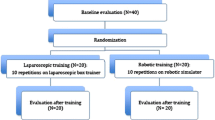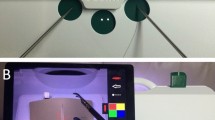Abstract
Background
The Minimally Invasive Surgical Trainer—Virtual Reality (MIST-VR) has been well validated as a training device for laparoscopic skills. It has been demonstrated that training to a level of proficiency on the simulator significantly improves operating room performance of laparoscopic cholecystectomy. The purpose of this project was to obtain a national standard of proficiency using the MIST-VR based on the performance of experienced laparoscopic surgeons.
Methods
Surgeons attending the Society of American Gastrointestinal Endoscopic Surgeons (SAGES) 2004 Annual Scientific Meeting who had performed more than 100 laparoscopic procedures volunteered to participate. All the subjects completed a demographic questionnaire assessing laparoscopic and MIST-VR experience in the learning center of the SAGES 2004 meeting. Each subject performed two consecutive trials of the MIST-VR Core Skills 1 program at the medium setting. Each trial involved six basic tasks of increasing difficulty: acquire place (AP), transfer place (TP), traversal (TV), withdrawal insert (WI), diathermy task (DT), and manipulate diathermy (MD). Trial 1 was considered a “warm-up,” and trial 2 functioned as the test trial proper. Subject performance was scored for time, errors, and economy of instrument movement for each task, and a cumulative total score was calculated.
Results
Trial 2 data are expressed as mean time in seconds in Table 2.
Conclusion
Proficiency levels for laparoscopic skills have now been established on a national scale by experienced laparoscopic surgeons using the MIST-VR simulator. Residency programs, training centers, and practicing surgeons can now use these data as guidelines for performance criterion during MIST-VR skills training.





Similar content being viewed by others
References
Brunner WC, Korndorffer JR, Sierra R, Dunne JB, Yau CL, Corsetti RL, Slakey DP, Townsend MC, Scott DJ (2005) Determining standards for laparoscopic proficiency using virtual reality. Am Surg 71: 29–35
Gallagher AG, Ledermen AB, McGlade K, Satava RM, Smith CD (2003) Discriminative validity of the Minimally Invasive Surgical Trainer—Virtual Reality (MIST-VR) using criteria levels based on expert performance. Surg Endosc 18: 660–665
Gallagher AG, Satava RM (2002) Virtual reality as a metric for the assessment of laparoscopic psychomotor skills: learning curves and reliability measures. Surg Endosc 16: 1746–1752
Grantcharov TP, Bardram L, Funch-Jensen P, Rosenberg J (2003) Learning curves and impact of previous operative experience on performance on a virtual reality simulator to test laparoscopic skills. Am J Surg 185: 146–149
Grantcharov TP, Kristianson VB, Bendix J, Bardram L, Rosenberg J, Funch-Jensen P (2004) Randomized clinical trial of virtual reality simulation for laparoscopic skills training. Br J Surg 91: 146–150
Jordan JA, Gallagher AG, McGuigan J, McClure N (2001) Virtual reality training leads to faster adaptation to the novel psychomotor restrictions encountered by laparosopic surgeons. Surg Endosc 15: 1080–1084
Kohn LT, Corrigan JM, Donaldson MS (1999) To err is human: building a safer health system. In: Committee on Quality of Health Care in America, Institute of Medicine, National Academy Press, Washington, DC
McClusky DA, Gallagher AG, Ritter EM, Ledermen AB, Sickle KRV, Baghai M, Smith CD (xxxx) Virtual reality training improves junior residents’ operating room performance: results of a prospective, randomized, double-blind study of the complete laparoscopic cholecystectomy. J Am Coll Surg (in press).
McClusky DA, Ritter EM, Ledermen AB, Gallaher AG, Smith CD (2005) Correlation between perceptual, visuospatial, and psychomotor aptitude to duration of training required to reach performance goals on the MIST-VR surgical simulator. Am Surg 71: 13–20
McNatt SA, Smith CD (2001) A computer-based laparoscopic skills assessment device differentiates experienced from novice laparoscopic surgeons. Surg Endosc 15: 1085–1089
Pearson A, Gallagher AG, Rosser JC, Satava RM (2002) Quantitative evaluation of five training methods for teaching intracorporeal knot tying. Surg Endosc 16: 130–137
Rosser JC, Rosser LE, Savalgi RS (1998) Objective evaluation of laparoscopic surgical skill program for residents and senior surgeons. Arch Surg 133: 657–661
Seymour N, Gallagher AG, O’Brien M, Roman S, Andersen D, Satava RM (2002) Virtual reality training improves operating room performance: results of a randomized, double-blind study. Ann Surg 236: 458–464
Author information
Authors and Affiliations
Corresponding author
Rights and permissions
About this article
Cite this article
Van Sickle, K.R., Ritter, E.M., McClusky, D.A. et al. Attempted establishment of proficiency levels for laparoscopic performance on a national scale using simulation: the results from the 2004 SAGES Minimally Invasive Surgical Trainer—Virtual Reality (MIST-VR) learning center study. Surg Endosc 21, 5–10 (2007). https://doi.org/10.1007/s00464-006-0011-x
Received:
Accepted:
Published:
Issue Date:
DOI: https://doi.org/10.1007/s00464-006-0011-x




